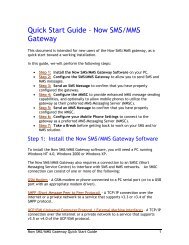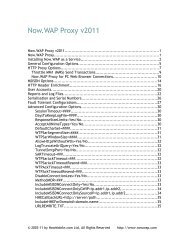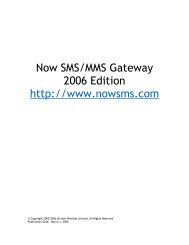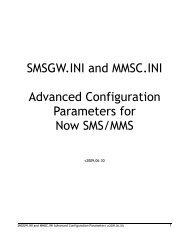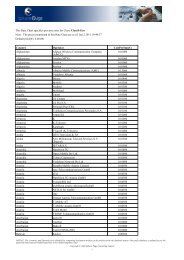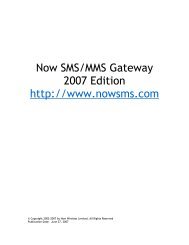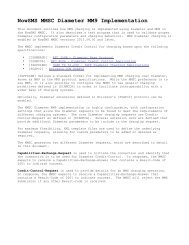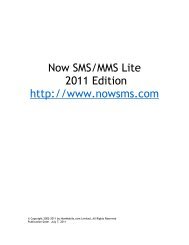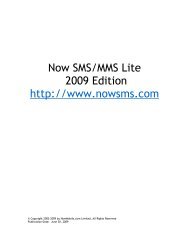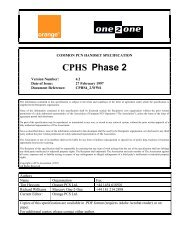NowWAP Proxy - NowSMS
NowWAP Proxy - NowSMS
NowWAP Proxy - NowSMS
Create successful ePaper yourself
Turn your PDF publications into a flip-book with our unique Google optimized e-Paper software.
Now.WAP <strong>Proxy</strong> v2010<br />
Now.WAP <strong>Proxy</strong> v2010 .....................................................................1<br />
Now.WAP <strong>Proxy</strong> .............................................................................1<br />
Installing Now.WAP as a Service .........................................................2<br />
General Configuration Options ...........................................................5<br />
HTTP <strong>Proxy</strong> Options ........................................................................7<br />
Throttle MM1 (MMS) Send Transactions ...............................................9<br />
Now.WAP <strong>Proxy</strong> for PC Web Browser Connections ................................10<br />
MSISDN Options ............................................................................14<br />
User Accounts ..............................................................................16<br />
Reports and Log Files .....................................................................18<br />
Serialisation and Serial Numbers .......................................................22<br />
Fault Tolerant Configurations ...........................................................23<br />
Advanced Configuration Options ........................................................26<br />
SessionTimeout=#### ...............................................................26<br />
DaysToKeepLogFile=#### ...........................................................26<br />
ResponseSizeLimits=Yes/No ........................................................26<br />
AcceptAllMimeTypes=Yes/No ......................................................26<br />
DefaultCharSet=#### ................................................................27<br />
WTPSarSegmentSize=#### ..........................................................27<br />
WTPSarWindowSize=#### ...........................................................27<br />
AllowHttpsWithoutWtls=Yes/No ...................................................28<br />
LogTruncateUrlQuery=Yes/No .....................................................28<br />
TunnelSmtpPort=Yes/No ............................................................28<br />
SARTimeout=### .....................................................................28<br />
WTPSarAckTimeout=### ............................................................28<br />
WTPSarAckTimeoutResend=### ...................................................29<br />
WTPAckTimeout=### ................................................................29<br />
WTPAckTimeoutResend=### .......................................................29<br />
DisableConnectionLess=Yes/No ....................................................29<br />
MethodMOR=### .....................................................................29<br />
IncludeMSISDNConnectOnly=Yes/No ..............................................29<br />
IncludeMSISDNConnectOnlyGWIP=ip.addr1,ip.addr2,... .......................30<br />
IncludeMSISDNConnectOnlySourceIP=ip.addr1,ip.addr2,... ...................30<br />
URLREWRITE.TXT ....................................................................31<br />
© 2003-10 by NowMobile.com Ltd, All Rights Reserved http://www.nowwap.com
NowMobile.com Limited<br />
Bourne House<br />
475 Godstone Road<br />
Whyteleafe, CR3 0BL, UK<br />
http://www.nowsms.com<br />
http://www.nowwap.com<br />
E-Mail: nowsms@nowsms.com<br />
UK Telephone : +44 1883 621100<br />
© 2003-10 by NowMobile.com Ltd, All Rights Reserved http://www.nowwap.com
Now.WAP <strong>Proxy</strong><br />
The Now.WAP <strong>Proxy</strong> is a high performance WAP Gateway that is designed to<br />
meet the needs of WAP 2.0 and multimedia applications, especially MMS<br />
(Multimedia Messaging Service) and Java downloads. With WAP providing the<br />
underlying protocol support for multimedia object delivery to mobile clients,<br />
the explosive growth of MMS services is placing heavy demands on conventional<br />
WAP gateways. The Now.WAP <strong>Proxy</strong> was designed to meet the needs of new<br />
MMS services, as well as legacy WAP applications.<br />
The Now.WAP <strong>Proxy</strong> provides full WAP gateway support for WAP v1.1, v1.2,<br />
v1.2.1, v1.3 and v2.0 WAP clients.<br />
The Now.WAP <strong>Proxy</strong> can support WAP 2.0 clients using either Wireless Profiled<br />
HTTP/TCP (W-HTTP and W-TCP), or the WSP protocol stack.<br />
Segmentation and re-assembly (SAR) is supported to provide support for larger<br />
object delivery to MMS (Multimedia Messaging Service) clients.<br />
To implement WAP Push and MMS services in conjunction with Now.WAP, we<br />
recommend the use of the Now SMS/MMS Gateway. More information regarding<br />
the Now SMS/MMS Gateway can be found at http://www.nowsms.com.<br />
The Now.WAP <strong>Proxy</strong> can be installed on Windows NT, Windows 2000, Windows<br />
XP, Windows Vista, Windows 2003 Server and Windows 2008 Server platforms.<br />
Both 32-bit and 64-bit platforms are supported. A 64-bit service version of the<br />
Now.WAP service is automatically installed on 64-bit platforms to provide<br />
increased speed and scalability.<br />
This help file provides details for configuring the Now.WAP <strong>Proxy</strong>.<br />
Now.WAP <strong>Proxy</strong> v2010 1
Installing Now.WAP as a Service<br />
For automatic operation, Now.WAP is best installed as a service. Services are<br />
automatically started by Windows when the machine is started. When<br />
Now.WAP is configured to run as a service, it will always be available, as long<br />
as the machine running Now.WAP is powered on and connected to the network.<br />
In order to operate as a service, Now.WAP must be installed when logged<br />
into Windows with a user account that has administrative privileges for<br />
the local machine. At startup, the Now.WAP configuration program will check<br />
to see that it has the required privileges to install or modify services. If these<br />
privileges are not available, Now.WAP will display an error message indicating<br />
that "Administrator rights are required for service installation or modification".<br />
To correct this error, you must login to Windows with a user account that has<br />
administrative privileges.<br />
Now.WAP <strong>Proxy</strong> v2010 2
In Windows Vista and Windows Server installations, even though you are<br />
logged in with an administrator account, Now.WAP may have to ask for further<br />
permission to access administrative tasks. In this case, Now.WAP will display<br />
the following dialog:<br />
After you confirm this dialog by pressing the "Yes" button, Windows will blank<br />
the screen and display a further dialog indicating that wap3gx.exe is requesting<br />
administrative privileges. It is necessary to select "Allow" to continue with the<br />
Now.WAP installation or configuration.<br />
Assuming that the necessary rights are available, the Now.WAP configuration<br />
can continue.<br />
Now.WAP <strong>Proxy</strong> v2010 3
The “Service” tab of the configuration dialog provides setup options for<br />
installing Now.WAP as a service.<br />
Check “Run as a service” to install and start the Now.WAP service.<br />
The “Start” and “Stop” buttons can be used to start and stop the service.<br />
To remove the Now.WAP service from the Windows services registry, uncheck<br />
“Run as a service”.<br />
The “Service” tab of the configuration dialog also displays information about<br />
the status of the currently running service, indicating how long the service has<br />
been running, the number of currently active users, and the number of<br />
requests processed by the gateway.<br />
Now.WAP <strong>Proxy</strong> v2010 4
General Configuration Options<br />
The “Options” tab of the configuration dialog is used for setting some of the<br />
more commonly used configuration options for the gateway.<br />
Check the “Use HTTP <strong>Proxy</strong> Server” checkbox if the gateway should forward all<br />
HTTP requests through an HTTP proxy server. Provide the IP address of the<br />
HTTP proxy server in the “HTTP <strong>Proxy</strong> Server” field. If a port number other<br />
than 80 is used by the proxy server, add a colon (:) and the port number to the<br />
proxy server IP address (e.g., 192.168.1.1:2080). If the HTTP <strong>Proxy</strong> Server<br />
requires a username and password for access, supply these settings in the<br />
“HTTP <strong>Proxy</strong> User Name” and “HTTP <strong>Proxy</strong> Password” fields.<br />
Now.WAP <strong>Proxy</strong> v2010 5
Older versions of the OpenWave/Phone.com browser installed on some phone<br />
models do not allow the home page to be set on the phone. For these legacy<br />
browsers, a default home page can be specified in the “Default home page for<br />
legacy browsers” field. Please specify a complete URL such as<br />
http://wap.mydomain.com/home.wml.<br />
The “IP Address Restrictions” settings can be used to restrict access to the<br />
gateway to a pre-defined set of IP addresses. If “Restrict access to the<br />
Gateway” is checked, then only the IP addresses listed in the “Addresses<br />
Allowed to Use Gateway” table will be allowed to access the gateway. If<br />
“Restrict access to the Gateway” is not checked, then any device can connect<br />
to the gateway.<br />
When adding IP Address restrictions, both an IP address and mask are specified.<br />
For example, to restrict access to only the IP address of 192.168.1.101, specify<br />
that address and a mask of 255.255.255.255. To restrict access to all IP<br />
addresses in the range 192.168.1.1 thru 192.168.1.254, specify any address<br />
within that range, and a mask of 255.255.255.0.<br />
After entering an IP address and mask, click “Add” to add the entry to the list.<br />
To remove an address from the allowed list, highlight the entry and click<br />
“Remove”.<br />
Note that after making any configuration changes in this dialog, it is necessary<br />
to click “Apply” or “OK” for the changes to be saved.<br />
Now.WAP <strong>Proxy</strong> v2010 6
HTTP <strong>Proxy</strong> Options<br />
The Now.WAP <strong>Proxy</strong> includes an HTTP <strong>Proxy</strong> Server interface that can be<br />
utilised by WAP 2.0 clients which support Wireless Profiled HTTP and TCP (W-<br />
HTTP and W-TCP). This interface can also be used as an HTTP proxy to provide<br />
speed enhancements for web browsing via a PC over a GPRS modem or other<br />
wireless connection.<br />
The HTTP (WAP2) <strong>Proxy</strong> server interface is enabled by checking “Enable HTTP<br />
(WAP2) <strong>Proxy</strong>”, and specifying an available port number on the local PC to be<br />
used as the “HTTP <strong>Proxy</strong> Port”. HTTP and WAP2 clients must then be<br />
configured to connect to the Now.WAP <strong>Proxy</strong> on this port to use the proxy<br />
services.<br />
Now.WAP <strong>Proxy</strong> v2010 7
When the “Enable Compression” setting is enabled, the Now.WAP <strong>Proxy</strong> will<br />
automatically compress requested files before transmitting them to the<br />
receiving client (when compression is supported by the receiving client).<br />
When the “Enable WTCP Extensions” setting is enabled, the Now.WAP <strong>Proxy</strong><br />
will enable certain Wireless Profile TCP extensions to provide optimum<br />
performance for wireless clients.<br />
Both the “Enable Compression” and “Enable WTCP Extensions” settings are<br />
enabled by default. It is recommended that these settings only be changed for<br />
troubleshooting purposes.<br />
The Now.WAP <strong>Proxy</strong> supports SSL/TLS tunneling, to support end-to-end<br />
encryption between WAP2 and HTTP clients and content servers. By default,<br />
the Now.WAP <strong>Proxy</strong> only supports SSL/TLS tunneling to content servers via the<br />
standard HTTP SSL/TLS port of 443. If you wish to enable SSL/TLS tunneling to<br />
other ports, check the “Allow SSL/TLS Tunnel to non-standard ports” setting.<br />
To help achieve optimum performance, the Now.WAP <strong>Proxy</strong> uses HTTP “Keep-<br />
Alive” connections whenever possible. By default, Now.WAP will allow a client<br />
device to maintain a “Keep-Alive” connection to the proxy for up to 300<br />
seconds. This means that a connected device can remain connected to the<br />
proxy for up to 300 seconds without making a request, eliminating the need to<br />
re-connect for each request. This value can be changed by entering a new<br />
value in the “Max Keep-Alive for Client Connections” field. A value of “0” can<br />
be used to disable all “Keep-Alive” connections to client devices.<br />
Similarly, the Now.WAP <strong>Proxy</strong> will maintain “Keep-Alive” connections to<br />
content servers whenever possible. By default, after issuing a request to a<br />
content server that supports “Keep-Alive”, Now.WAP will keep that connection<br />
alive for up to 90 seconds, and will re-use the connection for any additional<br />
requests. This value can be changed by entering a new value in the “Max<br />
Keep-Alive for Server Connections” field. A value of “0” can be used to disable<br />
all “Keep-Alive” connections to content servers.<br />
Now.WAP <strong>Proxy</strong> v2010 8
Throttle MM1 (MMS) Send Transactions<br />
Now.WAP is frequently used as a WAP <strong>Proxy</strong> front-end for an MMSC that<br />
facilitates MMS messaging services.<br />
Some MMSC configurations may have limits on the number of MMS send<br />
transactions that are allowed per second.<br />
Now.WAP can be configured to throttle MM1 send transactions, delaying them<br />
from being forwarded to the MMSC, in order to stay within licensing thresholds.<br />
This throttling functionality is enabled by checking "Throttle MM1 (MMS) Send<br />
Transactions".<br />
Throttling restrictions are defined as a number of messages (requests) allowed<br />
per second. To define a threshold of 3 messages per second, specify "3<br />
requests allowed per 1 second(s) interval". To define a a threshold of 1<br />
message every 2 seconds, specify "1 requests allowed per 2 second(s) interval".<br />
Most MMS clients will timeout if a response is not received within a timeout<br />
value that is specific to the MMS client. Therefore, it is necessary to specify a<br />
maximum amount of time that Now.WAP will hold the request if too many<br />
requests are already being throttled. In most instances, you will not want to<br />
allow a request to be held for more than 60 seconds, in order to prevent<br />
unnecessary client retries. When the maximum timeout is reached, the default<br />
behaviour of Now.WAP is to forward the request to the MMSC, even though the<br />
threshold has been exceeded. Alternatively, if "Request if max wait is<br />
exceeded" is checked, Now.WAP will return an error to the MMS client<br />
indicating that the network is busy and the request should be retried at a later<br />
time.<br />
Now.WAP <strong>Proxy</strong> v2010 9
Now.WAP <strong>Proxy</strong> for PC Web Browser Connections<br />
To use the Now.WAP <strong>Proxy</strong> to provide increased speed for connections from a<br />
web browser running on a PC, it is necessary to configure the web browser to<br />
use the Now.WAP <strong>Proxy</strong> as an HTTP 1.1 proxy for HTTP (and optionally HTTPS)<br />
connections. To configure these settings in Internet Explorer, follow these<br />
steps:<br />
Under Tools/Internet Options/Advanced, find the entry "Use HTTP 1.1 through<br />
proxy connections" and make sure this setting is checked. (Compression of<br />
content is only supported in the HTTP 1.1 interface.)<br />
Next, it is necessary to define the address of the proxy server to the web<br />
browser. This definition is applied under Tools/Internet Options/Connections.<br />
Now.WAP <strong>Proxy</strong> v2010 10
If you are using a dial-up connection for GPRS, highlight the dial-up definition<br />
in the "Dial-up and Virtual Private Network Settings" list, and select "Settings".<br />
Check "Use <strong>Proxy</strong> Server", and enter the IP address and port of the Now WAP<br />
<strong>Proxy</strong>.<br />
Now.WAP <strong>Proxy</strong> v2010 11
As the Now WAP <strong>Proxy</strong> does not support HTTP or Gopher, you may wish to go<br />
into the "Advanced" settings, and enable the proxy only for "HTTP" and<br />
"Secure", as shown below:<br />
Now.WAP <strong>Proxy</strong> v2010 12
If you are using a PC card that provides a GPRS connection using a network<br />
driver instead of dial-up (such as the Sierra Aircard), then the proxy server<br />
settings are defined under "LAN Settings" in Tools/Internet<br />
Options/Connections. Unfortunately, in this configuration, the proxy server<br />
settings apply to all network card connections, which can be inconvenient.<br />
Now.WAP <strong>Proxy</strong> v2010 13
MSISDN Options<br />
The “MSISDN” tab of the configuration dialog allows the gateway to interface<br />
with a Radius accounting server that is integrated with the service provider’s<br />
data network. This allows the gateway to determine the MSISDN (phone<br />
number) of a connected user.<br />
Note that this configuration is typically used only inside of a service provider’s<br />
data network, requiring that the WAP gateway be able to receive a Radius<br />
accounting feed from the provider’s dial-in server and/or GPRS network.<br />
Check “Activate Radius Accounting for MSISDN Collection” to enable a Radius<br />
accounting server that is built into the Now.WAP <strong>Proxy</strong>, and specify the port<br />
number on the local PC to be utilised. The default port number is 1813,<br />
Now.WAP <strong>Proxy</strong> v2010 14
although some older Radius services expect Radius accounting to listen to port<br />
1646. You will also need to configure a “Shared Secret” that is common to the<br />
Radius server.<br />
Once the “Radius accounting server” is enabled, the Radius servers on the<br />
service provider’s network should be configured to forward Radius Accounting<br />
packets to the Now.WAP <strong>Proxy</strong> on the specified port.<br />
Check “Activate Simple Radius Authentication Server” to enable a simple<br />
Radius authentication server built into the Now.WAP <strong>Proxy</strong>. By default, this<br />
Radius authentication server accepts all logins, regardless of user name and<br />
password, although it is possible to configure this server to authenticate<br />
against the user name and password list defined on the “Users” page of the<br />
Now.WAP <strong>Proxy</strong> configuration. This interface is provided primarily for<br />
environments where a Radius proxy is unable to separate the Radius accounting<br />
and Radius authentication feeds. By default, Radius authentication services<br />
listen to port 1812, although some older Radius services expect Radius<br />
authentication services to listen to port 1645.<br />
Check “Require MSISDN for all gateway connections” if you wish to only accept<br />
WAP connections where the MSISDN (phone number) of the device can be<br />
reliably determined. Note that this setting would normally only be used in an<br />
environment where the Now.WAP <strong>Proxy</strong> is tightly integrated with the service<br />
provider network.<br />
The gateway can forward the MSISDN of the WAP device to content servers via<br />
the “X-MSISDN:” HTTP header. Check “Forward ‘X-MSISDN:’ Header in content<br />
server requests” to enable this capability. For privacy reasons, it is possible to<br />
explicitly list the content servers and/or domains that will receive the “X-<br />
MSISDN:” header. When a content domain is added to the list, a host name<br />
that exactly matches the content domain, as well as any host names within the<br />
content domain will receive the “X-MSISDN:” header. For example, if<br />
“now.co.uk” is added to the content domain list, the “X-MSISDN:” header<br />
would be forwarded to a host named “now.co.uk” as well as for<br />
“www.now.co.uk” and “mms.now.co.uk”. If you wish to have the “X-MSISDN”<br />
header forwarded to all content servers, define a content domain named “*”.<br />
Now.WAP <strong>Proxy</strong> v2010 15
User Accounts<br />
In smaller configurations, it may be desirable to configure user accounts, so<br />
that a username and password are required for access to the Now.WAP <strong>Proxy</strong>.<br />
User accounts are defined on the “Users” page of the configuration dialog.<br />
A single user account list is supported. This user account list can be used to<br />
restrict access to the HTTP <strong>Proxy</strong> functions, the WAP/WSP <strong>Proxy</strong> functions, or<br />
it can be used for user account/password validation for the built-in RADIUS<br />
Authentication Server (the RADIUS Authentication Server is defined on the<br />
“MSISDN” page of the configuration).<br />
Now.WAP <strong>Proxy</strong> v2010 16
The user account list is stored as a text file in the Now.WAP <strong>Proxy</strong> gateway<br />
directory under a file name of USERS.TXT. This file can be edited outside of<br />
the Now.WAP <strong>Proxy</strong>. Each line of the text file should consist of a user name,<br />
followed by a comma, followed by the password for the account.<br />
Now.WAP <strong>Proxy</strong> v2010 17
Reports and Log Files<br />
The log files created by <strong>NowWAP</strong> are of a text format that follows the common<br />
log format for web servers.<br />
These log files are stored on the <strong>NowWAP</strong> server, with one log file created for<br />
each day, using a file naming convention of WAPGW-yyyymmdd.LOG, where<br />
yyyymmdd is the 4-digit year, 2-digit month and 2-digit day.<br />
<strong>NowWAP</strong> 2010 has optional functionality which can convert these log files into<br />
a database format for further analysis. This functionality is enabled by<br />
checking "Generate Usage Reports" on the "Reports" page of the configuration<br />
dialog.<br />
Now.WAP <strong>Proxy</strong> v2010 18
When usage reports are enabled, <strong>NowWAP</strong> will automatically generate daily<br />
and monthly usage reports.<br />
These reports are located in the REPORTS subdirectory of the <strong>NowSMS</strong><br />
installation.<br />
REPORTS\LOGDB contains SQLite format databases with one database per<br />
month.<br />
REPORTS\TEXT contains text format summary reports of <strong>NowWAP</strong> usage. Daily<br />
reports have file names of YYYYMMDD.TXT and monthly reports have file names<br />
of YYYYMM.TXT. Every night at midnight, a new daily report and updated<br />
monthly report for the current month will be generated.<br />
The format of the text report will be similar to the following:<br />
<strong>NowWAP</strong> Usage Report: YYYYMMDD<br />
#### - Max Active Users<br />
#### - Max Active Requests<br />
#### - Total Unique MSISDN<br />
#### - Total Sessions<br />
#### - Total Requests<br />
Top Active Users<br />
#### - Phone Number 1<br />
#### - Phone Number 2<br />
etc...<br />
Top Content Domains<br />
#### - Domain 1<br />
#### - Domain 2<br />
etc...<br />
Top Content Servers<br />
#### - Server 1<br />
#### - Server 2<br />
etc...<br />
Now.WAP <strong>Proxy</strong> v2010 19
REPORTS\XML contains XML formatted summary reports of <strong>NowWAP</strong> usage.<br />
Daily reports have file names of YYYYMMDD.XML and monthly reports have file<br />
names of YYYYMM.XML. Every night at midnight, a new daily report and<br />
updated monthly report for the current month will be generated.<br />
The format of the XML report will be similar to the following. Note that some<br />
XML elements may not be present, depending on <strong>NowWAP</strong> configuration issues.<br />
Also note that additional XML elements may be added in future releases.<br />
<br />
YYYYMMDD<br />
####<br />
####<br />
####<br />
####<br />
####<br />
<br />
Phone Number 1####<br />
Phone Number 2####<br />
<br />
<br />
Domain 1####<br />
Domain 2####<br />
<br />
<br />
Server 1####<br />
Server 2####<br />
<br />
<br />
ReportDate – YYYYMMDD for a daily report or YYYYMM for a monthly report.<br />
MaxActiveUsers – The maximum number of active (concurrent) users recorded<br />
during the report period. (Note: This information cannot be obtained from log<br />
files created by earlier versions of <strong>NowWAP</strong>.)<br />
MaxActiveRequests – The maximum number of simultaneous requests recorded<br />
during the report period. (Note: This information cannot be obtained from log<br />
files created by earlier versions of <strong>NowWAP</strong>.)<br />
TotalUniqueMsisdn – The number of unique MSISDN (phone numbers) that made<br />
requests of the proxy. (Note: Requires MSISDN/RADIUS integration.)<br />
TotalSessions – The number of user sessions during the report period.<br />
TotalRequests – The number of user requests serviced during the report period.<br />
TopActiveMsisdn – A list of the most active mobile terminals and the number of<br />
requests generated by that mobile terminal during the report period. (Note:<br />
Requires MSISDN/RADIUS integration.)<br />
Now.WAP <strong>Proxy</strong> v2010 20
TopContentDomains – A list of the content domains which recorded the most<br />
requests (hits) during the report period.<br />
TopContentServers – A list of the content servers which recorded the most<br />
requests (hits) during the report period.<br />
Now.WAP <strong>Proxy</strong> v2010 21
Serialisation and Serial Numbers<br />
The Now.WAP <strong>Proxy</strong> is licensed by active (or concurrent) users.<br />
When the Now.WAP <strong>Proxy</strong> is purchased, you will be provided with a serial<br />
number, user count and authorization code that must be entered into the<br />
“Serial #” tab of the configuration dialog. Enter this information and press<br />
“Add” to serialise the Now.WAP product.<br />
Now.WAP <strong>Proxy</strong> v2010 22
Fault Tolerant Configurations<br />
For many configurations, it is desirable to install Now.WAP on multiple servers<br />
in order to achieve fault tolerance and/or improved throughput and<br />
performance.<br />
Note that each Now.WAP server requires a unique serial number. Use of the<br />
same serial number on multiple servers will prevent fault tolerant configuration<br />
options from functioning correctly.<br />
The primary configuration concern when running Now.WAP in a clustered<br />
configuration is when Now.WAP is configured to use RADIUS accounting to<br />
supply MSISDN information to one or more content servers, such as an MMSC.<br />
This section describes how to configure multiple Now.WAP gateways to share<br />
this MSISDN information.<br />
To run Now.WAP in a load balanced configuration, the Now.WAP program files<br />
are installed locally on each server.<br />
A load balancer is used to route network traffic to any of the Now.WAP servers.<br />
Now.WAP <strong>Proxy</strong> v2010 23
In this type of environment, there is one shared IP address for which the load<br />
balancer accepts requests and routes them to any of the available Now.WAP<br />
servers.<br />
In addition to the single shared IP address, each of the Now.WAP servers has a<br />
unique local IP address that is not shared.<br />
The access server is configured to send RADIUS accounting packets to the<br />
shared IP address. Based upon server availability, the load balancer will route<br />
the RADIUS accounting packet to one of the Now.WAP servers. The RADIUS<br />
accounting packet could be routed to any of the Now.WAP servers.<br />
All of the Now.WAP servers are configured to listen for RADIUS accounting<br />
packets, with "Activate Radius Accounting for MSISDN Collection" checked on<br />
the "MSISDN" page of the Now.WAP configuration. The same "Port" number and<br />
"Shared Secret" should be configured on all Now.WAP servers, using the values<br />
expected by the access server.<br />
Manual edits must then be applied to the WAPGW.INI file of each Now.WAP<br />
server.<br />
Under the [WAPGW] section header of this file, configuration parameters must<br />
be added to specify that any RADIUS accounting packets received by this server<br />
should also be forwarded to the other server(s). The syntax of the<br />
configuration parameter is RadiusForward#=ip.address:port, where "#" is an<br />
incrementing number for each definition beginning with 1, "ip.address" is the<br />
non-shared IP address of another Now.WAP server, and "port" is the Radius<br />
Accounting port number (if not specified, the default is 1813).<br />
As an example of this configuration, assume a configuration where 3 Now.WAP<br />
servers are load balanced with a shared IP address of 10.10.10.10. The nonshared<br />
(local) IP addresses for the 3 servers are 10.10.10.1, 10.10.10.2, and<br />
10.10.10.3.<br />
The access server is configured to send RADIUS accounting packets to<br />
10.10.10.10 (the shared IP address).<br />
The Now.WAP server on 10.10.10.1 has the following configuration settings<br />
under the [WAPGW] header of WAPGW.INI:<br />
RadiusForward1=10.10.10.2<br />
RadiusForward2=10.10.10.3<br />
The Now.WAP server on 10.10.10.2 has the following configuration settings<br />
under the [WAPGW] header of WAPGW.INI:<br />
Now.WAP <strong>Proxy</strong> v2010 24
RadiusForward1=10.10.10.1<br />
RadiusForward2=10.10.10.3<br />
The Now.WAP server on 10.10.10.3 has the following configuration settings<br />
under the [WAPGW] header of WAPGW.INI:<br />
RadiusForward1=10.10.10.1<br />
RadiusForward2=10.10.10.2<br />
Troubleshooting Notes<br />
1.) For troubleshooting purposes, it may be easiest to first configure the access<br />
server to send the RADIUS Accounting packets to the non-shared IP address of<br />
just one of the Now.WAP servers. Once that is working properly, change the<br />
access server to send the RADIUS Accounting packets to the shared IP address<br />
of the load balanced cluster.<br />
2.) Now.WAP logs all received RADIUS transactions in log files named RADIUSyyyymmdd.LOG<br />
(yyyymmdd is the current date). Refer to these log files for<br />
details regarding RADIUS Accounting packets received by Now.WAP.<br />
3.) For further troubleshooting, it may be helpful to use a network traffic<br />
analyzer, such as Wireshark (formerly known as Ethereal).<br />
Now.WAP <strong>Proxy</strong> v2010 25
Advanced Configuration Options<br />
Several additional configuration options may be applied by directly editing the<br />
WAPGW.INI file, located in the Now.WAP program directory.<br />
The configuration settings described in this section may be entered into the<br />
WAPGW.INI file under the [WAPGW] section header.<br />
SessionTimeout=####<br />
This setting specifies a timeout value, in minutes, after which a gateway<br />
session will be automatically timed out. The default value is 10 minutes. Use<br />
caution when setting this value to lower values, as while most clients will<br />
automatically reconnect after a session timeout, some clients will report an<br />
error message.<br />
DaysToKeepLogFile=####<br />
This setting specifies the number of days to keep log files. The default value is<br />
90 days. These are the WAPGW-YYYYMMDD.LOG files that the gateway<br />
maintains to track access. Note that the log files follow the standard format<br />
for a web server log file.<br />
ResponseSizeLimits=Yes/No<br />
When this setting is set to No, the gateway will not enforce any limits on the<br />
response size of data that is sent back to a mobile device. By default this<br />
setting is set to Yes, and the gateway will not sent any responses to a mobile<br />
device which exceed the response size that the device indicates that it will<br />
accept. The default setting is No.<br />
AcceptAllMimeTypes=Yes/No<br />
When this setting is set to Yes, the gateway will not reject responses from<br />
content servers that are in a MIME type that the client has not indicated that it<br />
will accept. By default this setting is set to No, and the gateway will return an<br />
error if a content server returns a MIME type that the client has not indicated<br />
that it will accept.<br />
Now.WAP <strong>Proxy</strong> v2010 26
DefaultCharSet=####<br />
This setting specifies a default Windows character set to be assumed for WAP<br />
content. By default, the gateway assumes that the UTF-8 character set is<br />
used, unless a “charset” header exists within a WML page. The mapping of<br />
MIME character sets to Windows character sets is automatically read from the<br />
Windows registry (HKEY_CLASSES_ROOT\MIME\Database\Charset). Additional<br />
character set mappings can be defined in a CHARSET.INI file, an example of<br />
which is shown below. Note that if the DefaultCharSet setting is used to<br />
specify a default character set, you must specify the Windows code page<br />
number, and not the MIME character set name.<br />
[Charset]<br />
us-ascii=1252<br />
iso-8859-1=1252<br />
iso-8859-2=1250<br />
iso-8859-4=1257<br />
iso-8859-5=1251<br />
iso-8859-6=1256<br />
iso-8859-7=1253<br />
iso-8859-8=1255<br />
iso-8859-9=1254<br />
big5=950<br />
big-5=950<br />
gbk=936<br />
gb2312=936<br />
gb2312-80=936<br />
shift-jis=932<br />
shift_jis=932<br />
iso-2022-kr=949<br />
korean=949<br />
ks_c_5601=949<br />
KSC_5601=949<br />
KSC5601=949<br />
KSC-5601=949<br />
WTPSarSegmentSize=####<br />
This setting specifies the maximum segment size in bytes to be used in<br />
segmentation and reassembly (SAR) responses generated by the gateway. The<br />
default setting is 1400 bytes.<br />
WTPSarWindowSize=####<br />
This setting specifies the window size (number of packets sent without<br />
acknowledgement) to be used in segmentation and reassembly (SAR) responses<br />
generated by the gateway. The default setting is 3.<br />
Now.WAP <strong>Proxy</strong> v2010 27
AllowHttpsWithoutWtls=Yes/No<br />
Available in the WTLS version only, when this setting is set to Yes, the gateway<br />
will make HTTPS (SSL/TLS) connections to content servers, even when the<br />
client device did not use WTLS to connect to the gateway. The default setting<br />
for this parameter is No, meaning that the gateway will only make HTTPS<br />
connections on behalf of clients that have used WTLS to connect to the<br />
gateway.<br />
LogTruncateUrlQuery=Yes/No<br />
By default, URL GET parameters are not included in the URL requests written<br />
to the log files. To include URL GET parameters in the log file, this parameter<br />
should be set to Yes.<br />
TunnelSmtpPort=Yes/No<br />
The SSL/TLS tunnel functionality of the HTTP <strong>Proxy</strong> allows clients to use any<br />
protocol, not just HTTP SSL/TLS, to connect to external content servers. To<br />
prevent abuse of this functionality, by default the Now.WAP <strong>Proxy</strong> only<br />
supports tunnel connections to the standard HTTP SSL/TLS port of 443. A menu<br />
based configuration setting allows tunnel connections to be enabled for other<br />
non-standard ports. However, by default, the Now.WAP <strong>Proxy</strong> will still not<br />
allow connections to port 25 (the standard SMTP port) via the HTTP tunnel<br />
facility unless this configuration parameter is present in the INI file with a<br />
setting value of Yes.<br />
SARTimeout=###<br />
When receiving a segmented request from a WSP client, this setting specifies<br />
the maximum number of minutes that the server will wait for a client to send<br />
the next segment before considering the request aborted. The default value is<br />
5.<br />
WTPSarAckTimeout=###<br />
When sending a segmented response to a client, this is the maximum number of<br />
seconds that the server will wait for an acknowledgment before aborting the<br />
response. The default value is 90 seconds.<br />
Now.WAP <strong>Proxy</strong> v2010 28
WTPSarAckTimeoutResend=###<br />
When sending a segmented response to a client, this is the maximum number of<br />
seconds that the server will wait for an acknowledgment for any segment that<br />
requires acknowledgment before resending the current segment. The default<br />
value is 8 seconds.<br />
WTPAckTimeout=###<br />
When sending a simple (non-segmented) response to a client, this is the<br />
maxmium number of seconds that the server will wait for an acknowledgment<br />
before aborting the response. The default value is 90 seconds.<br />
WTPAckTimeoutResend=###<br />
When sending a simple (non-segmented) response to a client, this is the<br />
maximum number of seconds that the server will wait for an acknowledgment<br />
of the response before resending the response. The default value is 5 seconds.<br />
DisableConnectionLess=Yes/No<br />
This setting can be set to Yes to disable support for legacy WAP/WSP<br />
connectionless requests on UDP port 9200. The connectionless protocol is<br />
limited to a single packet and does not work well for requests larger than 1500<br />
bytes. The default value is No (connectionless support enabled).<br />
MethodMOR=###<br />
This setting sets the maximum value that the server will return for the<br />
"Maximum Outstanding Method Requests" field in a WAP/WSP connection<br />
request. The default value is 50. This value specifies the maximum number of<br />
concurrent transactions allowed between the client and the server. Note that<br />
Now.WAP does not enforce this MOR connection limit, and sets this value<br />
merely as advice for the client.<br />
IncludeMSISDNConnectOnly=Yes/No<br />
Setting this value to "Yes" indicates that Now.WAP should only allow proxy<br />
requests to connect to domains and hosts that are listed in the "Content<br />
Now.WAP <strong>Proxy</strong> v2010 29
Domains to receive X-MSISDN header" list on the "MSISDN" page of the Now.WAP<br />
configuration dialog. Any attempts to connect to a domain or host name that is<br />
not in this list will result in the proxy returning an "Access Denied" error. This<br />
setting is active even if RADIUS support has not been enabled for MSISDN<br />
collection. This setting is intended primarily for configurations where the WAP<br />
proxy is acting only to support a single service, such as an MMSC. The default<br />
value for this setting is "No".<br />
IncludeMSISDNConnectOnlyGWIP=ip.addr1,ip.addr2,...<br />
This setting works similar to the IncludeMSISDNConnectOnly=Yes setting,<br />
however it applies this setting only for selected server IP addresses, if the<br />
Now.WAP server is running as a multi-homed server will multiple IP addresses.<br />
For example, if the Now.WAP server is running on multiple network interfaces<br />
with IP addresses of 10.0.0.100 and 192.168.1.100, you may want Now.WAP to<br />
act as an open proxy for connections to the 10.0.0.100 server, while restricting<br />
connections to the 192.168.1.100 server. In this case, define<br />
IncludeMSISDNConnectOnlyGWIP=192.168.1.100, and any connections that the<br />
Now.WAP server receives on the 192.168.1.100 interface will be restricted to<br />
the domains and/or host names in the "Content Domains to receive X-MSISDN<br />
header" list on the "MSISDN" page of the Now.WAP configuration dialog.<br />
IncludeMSISDNConnectOnlySourceIP=ip.addr1,ip.addr2,...<br />
This setting works similar to the IncludeMSISDNConnectOnly=Yes setting,<br />
however it applies this setting only for selected client IP addresses. For<br />
example, if the Now.WAP server is supporting clients that are assigned to<br />
multiple different IP address ranges, you may want Now.WAP to act as an open<br />
proxy for clients from one IP address range, while limiting access for other<br />
clients to selected hosts. For example, assume that you have two APNs, one<br />
for browser connections, and another only for MMS traffic. The browser APN<br />
assigns client IP addresses in the 10.0.0.0 network, and the MMS APN assigns<br />
client IP addresses in the 192.168.0.0 network. In this case, define<br />
IncludeMSISDNConnectOnlySourceIP=192.168.*.*, and any connections that the<br />
Now.WAP server receives from clients on the 192.168.0.0 network will be<br />
restricted to the domains and/or host names in the "Content Domains to<br />
receive X-MSISDN header" list on the "MSISDN" page of the Now.WAP<br />
configuration dialog. Note that this setting does not support address masks,<br />
but the "*" wildcard character can be used as a placeholder in any part of the IP<br />
address. This setting allows for a comma delimited list of multiple client<br />
source IP addresses.<br />
Now.WAP <strong>Proxy</strong> v2010 30
URLREWRITE.TXT<br />
The URLREWRITE.TXT file is a special file that can be created in the Now.WAP<br />
program directory.<br />
The URLREWRITE.TXT file is a standard text file that can be created and edited<br />
with a basic text editor such as Windows Notepad.<br />
Each line of this file can contain the start of a URL, and how it should be<br />
translated/redirected.<br />
For example, if you have clients that are pre-configured to start at a homepage<br />
of http://homepage, you can define a redirection in this file to redirect the<br />
request to a different server, such as:<br />
http://homepage=http://domain.name/path/page<br />
Now.WAP <strong>Proxy</strong> v2010 31





